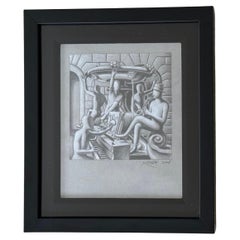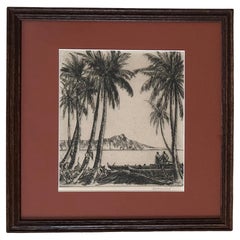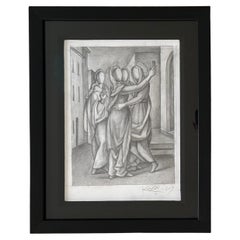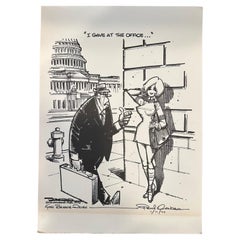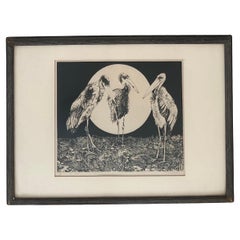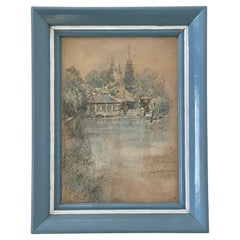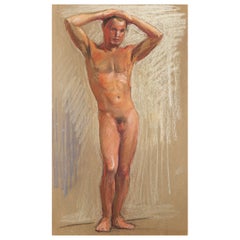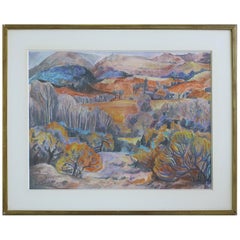Klassik Design Drawings
to
5
14
9
5
Height
to
Width
to
2
1
9
5
4
3
2
12
6
2
1
12
12
2
2
14
14
14
4
1
1
1
1
Original Signed Pencil Drawing Entitled "Letting it Flow" by Mark Kostabi
By Mark Kostabi
Located in San Diego, CA
Original signed pencil drawing entitled "Letting it Flow" by Mark Kostabi, circa 2008. The piece is in very good condition and is hand-signed /dated in pigment in the lower right. T...
Category
21st Century and Contemporary American Modern Drawings
Materials
Wood, Paper
Aquatint Etching "Hawaii" by Listed Artist Alexander Samuel MacLeod
Located in San Diego, CA
Beautiful aquatint etching entitled "Hawaii" by listed artist Alexander Samuel MacLeod, circa 1940s. The piece is in very good vintage condition and is hand signed in pencil in the l...
Category
Early 20th Century American Drawings
Materials
Paper
Original Signed Pencil Drawing Entitled "Re-visitation" by Mark Kostabi
By Mark Kostabi
Located in San Diego, CA
Original signed pencil drawing entitled "Re-visitation" by Mark Kostabi, circa 2019. The piece is hand-signed /dated in pigment lower right and signed and titled on the verso. This ...
Category
21st Century and Contemporary American Drawings
Materials
Wood, Paper
"Los Angeles Times" Political Cartoon Drawing - by Paul Conrad
Located in San Diego, CA
A "Los Angeles Times" political cartoon drawing captioned "I Gave At The Office..." by award winning cartoonist Paul Conrad, circa 1977. The drawing is a reprint of the original pen ...
Category
Mid-20th Century American Mid-Century Modern Drawings
Materials
Plastic, Paper
Vintage Aquatint Etching "3 Storks" by Jack Coughlin
Located in San Diego, CA
Vintage aquatint etching entitled "3 Storks" by Jack Coughlin, circa 1980. The piece is hand signed and titled in pencil by the artist. The image (plate mark) is 13.5" x 12" and the ...
Category
Late 20th Century American Drawings
Materials
Wood, Paper
Original Pastel Drawing "Le Pont de Passes Grilles" by George Wharton Edwards
By George Edwards
Located in San Diego, CA
Original pastel and graphite drawing "Le Pont de Passes Grilles" by George Wharton Edwards, circa early 1900s. The drawing is in good antique co...
Category
Early 20th Century French Mid-Century Modern Drawings
Materials
Crayon
$600 Sale Price
20% Off
Pastel Drawing of Mother Child on Paper by Leon Pierre Collard
Located in San Diego, CA
Figurative pastel painting of mother and child drawing on paper by Leon Pierre Collard (1916-2011). This drawing is rendered nicely and the im...
Category
Late 20th Century American Drawings
Materials
Paper
$780 Sale Price
20% Off
Charcoal Collage Portrait by Judith Klausenstock
Located in San Diego, CA
Charcoal collage portrait by Judith klausenstock. Klausenstock has a B.A. in fine art from Hardvard University.
Collage #95 is dark brown and blue-gray on off white background. S...
Category
2010s American Drawings
Materials
Paper
$740 Sale Price
20% Off
Vintage Chicago / Lake Michigan Etching "Along the Lake" by James Swann
Located in San Diego, CA
Vintage Chicago / Lake Michigan drypoint etching "Along the Lake" by noted artist James Swann, circa 1960. The piece is hand signed and titled in penci...
Category
Mid-20th Century American Drawings
Materials
Paper, Wood
Vintage Dry Point Etching "Bison" by Józef Hecht
By Józef Hecht
Located in San Diego, CA
Vintage dry point etching "Bison" by noted artist Józef Hecht, circa 1930s. The piece is hand signed and titled in pencil by the artist and numbered 18 of 40 in the lower left. The i...
Category
Early 20th Century French Drawings
Materials
Paper
Original Signed Pencil Drawing Entitled "Breakfast in Bed" by Mark Kostabi
By Mark Kostabi
Located in San Diego, CA
Original signed pencil drawing entitled "Breakfast in Bed" by Mark Kostabi, circa 2015. The piece is hand-signed /dated in pigment lower right and signed and titled on the verso. Th...
Category
21st Century and Contemporary American Drawings
Materials
Wood, Paper
$3,000 Sale Price
20% Off
Original Signed Pencil Drawing Entitled "Within Reach" by Mark Kostabi
By Mark Kostabi
Located in San Diego, CA
Original signed pencil drawing entitled "Within Reach" by Mark Kostabi, circa 2011. The piece is hand-signed /dated in pigment lower right and signed and titled on the verso. This i...
Category
21st Century and Contemporary American Drawings
Materials
Wood, Paper
$3,600 Sale Price
20% Off
Warner Brothers "Bugs Bunny" Original Animation Production Cell by Friz Freleng
By Warner Brothers Studios, Isadore (Friz) Freleng
Located in San Diego, CA
A very rare and authentic Warner Brothers "Bugs Bunny" original hand-painted animation production cell by Friz Freleng, circa 1982. The drawing of Bugs Bunny playing tennis is from a...
Category
Mid-20th Century American Drawings
Materials
Plastic
Vintage Dry Point Etching "Going to the Wagon #1" with Doodle by Edward Borein
By Edward Borein
Located in San Diego, CA
Vintage dry point etching "Going to the Wagon, No. 1" with original pencil doodle by noted western artist, Edward Borein, circa early 1900s. The piece is hand signed in pencil by the artist in the lower right and contains a small original pencil doodle in the lower left of a cowboy on a horse. The image (plate mark) is 9.875" x 7.875 and the piece is presented in a custom oak frame measuring 19" x 15.25" with a double cut cream mat. Overall, the etching is in very good vintage condition. This outstanding work is also titled "The Texans" and is extremely rare with the small doodle sketch by Borein. #4452
Born in San Leandro, California, Edward Borein became one of the most popular artists of western scene painting, equally adept at ink drawing, watercolor, and etching.
He was raised in San Leandro, a western cow town, in a family where his father was a county politician. Edward had many childhood memories of herded cattle and their cowboys, which he began sketching at the age of five. He was educated in the Oakland, California schools, and at the age of 17 began working on a ranch near Oakland and then drifted and sketched as a working cowboy throughout the Southwest, Mexico, and Guatemala. It was said that he practiced his art on anything he could find from bunkhouse walls to scraps of paper. At age 19, he enrolled at the San Francisco Art School, his only formal art training, and there he met Jimmy Swinnerton and Maynard Dixon who encouraged him in his art career. The first person to purchase his work was Charles Lummis, editor of The Land and Sunshine magazine in California, and the two became life-long friends. Borein and Lucille Maxwell were married in the Lummis home. Borein, a typical westerner in dress and manner, also became close friends with Charles Russell, actor Will Rogers, and President Theodore Roosevelt. Borein often traveled north to visit Russell in Great Falls, Montana and to travel among Indian tribes. In 1899, Borein visited Arizona while returning from Mexico. By 1902, he was a successful illustrator in San Francisco for the San Francisco Call, and in 1907 to enhance his illustration skills, went to New York to learn etching techniques. There he enrolled in the Art Students League and was a student of Child Hassam. In the theatre district, he opened a studio that became a gathering place for 'lonesome' westerners such as Charles Russell, Will Rogers, Olaf Seltzer...
Category
Early 20th Century American Drawings
Materials
Paper
Related Items
"Standing Male Nude, " Pastel Drawing by Allyn Cox, US Capitol Muralist
By Allyn Cox
Located in Philadelphia, PA
Beautifully executed in warm, roseate colors -- coral, terra cotta, brick and ivory -- this drawing was made by Allyn Cox, probably as a study for one of many murals he was commissioned to paint at the US Capitol...
Category
Vintage 1950s American Art Deco Drawings
Materials
Paper
$1,760 Sale Price
20% Off
H 20.5 in W 12 in D 0.1 in
Willy Eisenschitz Original pastel
Located in Encino, CA
Willy Eisenschitz, "Provence View", "Paysage de Provence"
Pastel on paper
Measures: H 23" 1/2 x 30" 1/2 x 1/2" with frame
H 17" 3/4 x 23" 3/4 (visibl...
Category
Vintage 1930s Austrian Drawings
Materials
Paper
"Contemplation, " Brilliantly-Hued Pastel Drawing of Standing Male Nude by Cox
By Allyn Cox
Located in Philadelphia, PA
Sensuous and vividly-hued, this pastel drawing of a standing male nude with his head resting against the wall was made by Allyn Cox, son of the famous muralist Kenyon Cox...
Category
Vintage 1930s American Art Deco Drawings
Materials
Paper
$2,750
H 24 in W 18 in D 0.1 in
Wall Decoration Art Pair Silhouettes Black Framed Antique Los Angeles Gallery
Located in West Hollywood, CA
Wall Decoration Art Pair Silhouettes Black Framed Antique Los Angeles Gallery . Pair of silhouettes portrays the 19th century Lady and Gentleman With his Hat. This pair has been well taken care of and has minor wear consistent with the age. Wall art Silhouette of a Lady and a Gentleman framed in possible hand carved pine wood or fruitwood Frame.
Charming elegant profile depicts high status man at ease with himself ensured his place in hierarchy looking sharp and same goes for the Lady holding what appears to be a document. The subjects are dapperly dressed with his top hat in his hand, trimmed haircut, leather boots and the lady with a nice Hairdo and an elaborate dress. An original continental French or British silhouette in a period fruitwood light color frames and are beveled. Antique dealer Los Angeles West Hollywood La Cienega Melrose Ave. The watercolor and paper cut silhouettes...
Category
Antique 19th Century European Decorative Art
Materials
Metal
$1,360 Sale Price
20% Off
H 13.75 in W 8.75 in D 1.5 in
20th Century Signed Still Life Pencil Drawing
Located in Roma, IT
Beautiful, evocative Pencil Drawing
Still Life with Flowers and Butterfly
Early 20th century
Signed at lower right
The painting is embellished by a beautiful nineteenth-century la...
Category
Vintage 1920s Italian Art Nouveau Paintings
Materials
Wood, Paper
Pair Of Framed Persian Original Pencil Drawing Works
Located in Bridgeport, CT
Pair of Persian original figural landscape pencil drawings surmounted on paper.
Presented in faux paint decorated frames, French matted with gold embellishments, glazed.
Dimensions:...
Category
Early 20th Century Asian Bakshaish Drawings
Materials
Glass, Wood, Paper
Drawing "Rive" Paul de Pignol, 2018
Located in PARIS, FR
Born in Toulouse in 1965, Paul de Pignol studied at the Ecole Nationale Supérieure des Beaux-Arts in Paris in the painting studio of Pierre Carron. He l...
Category
2010s French Drawings
Materials
Paper, Crayon
Pair of Early Victorian English Stamped Framed & Mounted Cornwall Aquatints
Located in Vancouver, British Columbia
Fine pair of Fisher & Son London hand coloured engravings from the early Victorian Period. Beautifully framed and mounted and in good condition. Detailed scenes of Cornwall...
Category
Antique 1830s English Early Victorian Decorative Art
Materials
Paper
$1,440 Sale Price / set
20% Off
H 8.5 in W 10.5 in D 0.5 in
Original Drawing by Javier Calleja (1971), Haden
By Javier Calleja
Located in Berlin, DE
Javier Calleja (1971)
Untitled (Haden)
2017
Pencil and colored pencil on paper, signed, dated, and titled (under mat)
11.9 x 8.2 in / 30 x 21 cm
Framed in oak
In impeccable condition...
Category
2010s European Drawings
Materials
Paper
Martin Kline "Untitled" Abstract Pencil Drawing 1997 'Signed and Dated'
By Martin Kline
Located in New York, NY
Beautifully framed original abstract drawing, Untitled, 1997, pencil on paper, 30" x 22" sheet, by Martin Kline, signed and dated in lower left.
Martin Kline’s (b. 1961) work ref...
Category
1990s American Modern Drawings
Materials
Ash, Paper
$5,500
H 35.5 in W 27.5 in D 1.5 in
Unknown Academy Student 19th C Drawing, Pencil on Paper, Framed, Signed
Located in Leuven , BE
Unknown academy student 19th C drawing, pencil on paper, Framed, Signed.
Category
Antique 19th Century Belgian Drawings
Materials
Paper
$713
H 29.53 in W 22.45 in D 1.97 in
Framed Drawing by Mexican Artist José Luis Cuevas
By José Luis Cuevas
Located in Atlanta, GA
Ink and watercolor on Paper by José Luis Cuevas (Mexican, b.1934). Featuring characters from a story line inscribed lower left as the following (see ...
Category
Vintage 1960s Mexican Modern Drawings
Materials
Paper
